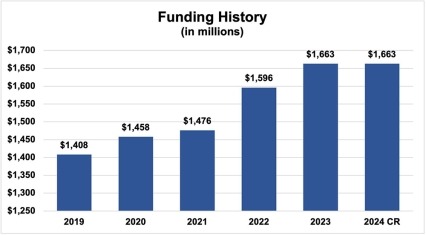The National Institute on Drugs and Addiction¹ (NIDA) advances science on substance use and addiction to improve individual and public health. After decades of research, substance use disorder (SUD) is now understood to be a chronic, treatable brain condition. NIDA-funded research has led to effective prevention and treatment approaches, helping millions of Americans lead healthier lives, reduce their overdose risk, and recover from SUD.
The Addiction Public Health Crisis
- 46.3 million people in the United States had an SUD in 2021.2
- In 2021, only 6.3 percent of people with SUD received treatment.2
- In 2022, about 110,000 people died of drug overdoses.3
- Black and American Indian/Alaska Native people are estimated to have the highest rates of fatal overdose.4
FY 2023 Research Investment
- 419 Full-time equivalents
- 399 New research project grants
- 566 Unique investigators
- 106 Early-stage investigators
- $753M for opioids research
- $279M for HIV/AIDS research
Fostering the Next Generation of Addiction Scientists
- NIDA is helping grow an addiction science workforce that represents the Nation’s diverse populace while also capturing diverse disciplines. As part of its Racial Equity Initiative, NIDA recently announced new programs designed to help diverse students and postdoctoral researchers cross-train in addiction science, Big Data, and artificial intelligence.
- NIDA’s training programs support addiction scientists at all career stages, from undergraduates to
postdoctoral trainees and clinicians working to become independent investigators. - NIDA continues to prioritize early-career support, including special consideration for research applications from Early-Stage Investigators.
Recent Accomplishments and New Programs
Investing in Basic Neuroscience
- Through structure-function analyses of the mu-type opioid receptor, NIDA-funded researchers designed synthetic opioid analgesics that have lower risks of addiction and overdose.
- Recent research shows that people with opioid use disorder (OUD) have unique daily rhythmic patterns of gene activity in brain regions that influence addiction. The interplay of sleep, circadian rhythms, and SUD is the focus of a new NIDA research program.
Understanding Risk, Strengthening Prevention
- The Adolescent Brain Cognitive Development (ABCD) Study has found that childhood adversity can have
significant effects on brain development and mental health, including the risk of SUD. Ongoing research is exploring ways to intervene in early-life risks for SUD. - The NIDA Clinical Trials Network has developed and validated simple tools for early screening of
substance use and SUD and is investigating ways to integrate SUD screening into primary care. - Working with other NIH Institutes and federal partners, NIDA is supporting a National Academies
consensus study to advise on a prevention infrastructure for SUD and other mental health disorders.
Therapeutics Development and Testing
- NIDA support has led to more than 50 Investigational New Drug applications for SUD since 2019.
- A NIDA-pharma collaboration led to the Food and Drug Administration’s 2023 approval of intranasal
nalmefene—an opioid reversal agent with longer-lasting effects than naloxone. - Potential therapies under development include vaccines, monoclonal antibodies, and sequestrants
designed to trap drugs, as well as psychedelic-based therapies to reset brain circuits underlying addiction.
Innovation and Entrepreneurship
- NIDA provided early funding to startups to tackle the overdose crisis in unique ways, such as by monitoring wastewater for patterns of drug use and providing SUD care by telehealth.
- A new NIDA program calls for research on deployable, low-cost, point-of-need approaches and
technologies to lower barriers to SUD care.
Bringing Proven Interventions into Broader Practice
- The Justice Community Opioid Innovation Network (JCOIN) found that expanding access to medications
for OUD in prisons and jails could reduce overdose deaths among recently incarcerated people. JCOIN’s
new online tool even helps prison and jail administrators budget for these medications. - A new harm reduction research network supports research on interventions to reduce overdose and other harms from SUD, with a focus on reaching underserved populations.
Addressing Disparities
- The HEAL-funded program Native Collective Research Effort to Enhance Wellness (N-CREW) will partner
researchers with Tribes and Native American-serving organizations to support community-based research and solutions for overdose, substance use, mental health, and pain.
References
- The FY 2025 President’s Budget proposes to rename the National Institute on Drug Abuse to the National Institute on Drugs and Addiction.
- 2021 National Survey on Drug Use and Health
- 2022 CDC/National Center for Health Statistics
- CDC WONDER Provisional Mortality data
Download as a PDF - Summary CJ fact sheet for FY25 (3.6 MB)


